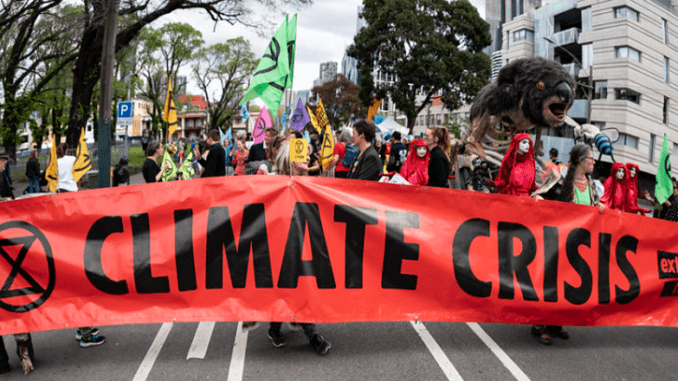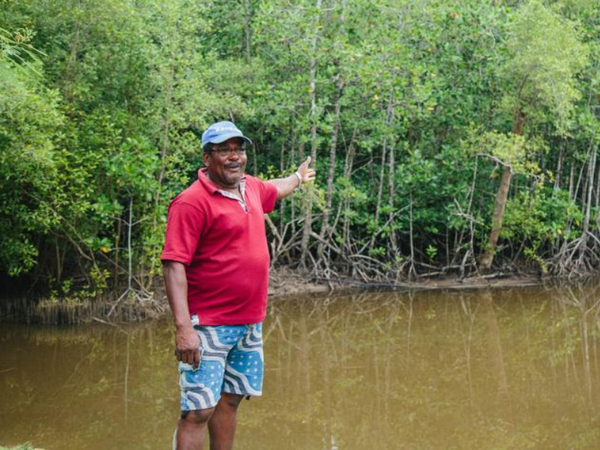
BONN, Germany, October 27, 2022 (ENS) – Countries’ climate promises fall far short of avoiding catastrophic global warming, the United Nations’ climate agency warned Wednesday in a new analysis ahead of the annual UN climate conference, COP27, opening in Egypt in just 10 days.
National climate plans filed with the United Nations by most countries that signed the Paris Agreement would cut global greenhouse gas emissions, but they are still not ambitious enough to limit global temperature rise to 1.5 degrees Celsius by the end of the century – one of the agreement’s goals.
Instead, the plans, called National Determined Contributions, are pushing the planet to at least 2.5 degrees Celsius of warming, the analysis shows, a level deemed catastrophic by scientists at the Intergovernmental Panel on Climate Change, IPCC.
In 2019, the IPCC reported that to limit global warming, emissions of the most prevalent greenhouse gas, carbon dioxide (CO2), must be cut 43 percent by 2030, compared to 2010 levels, but instead current climate plans show a 10.6 percent increase.
Still, this is an improvement compared to last year’s report, which showed a 13.7 percent increase by 2030, and a continued rise of emissions after 2030.
“The downward trend in emissions expected by 2030 shows that nations have made some progress this year,” said Simon Stiell of Grenada, the new executive secretary of UN Climate Change.

UN Secretary-General Antonio Guterres announced Stiell’s appointment on August 15. He replaces Patricia Espinosa of Mexico, who served as UNFCCC head from 2016 until July 2022.
“But the science is clear and so are our climate goals under the Paris Agreement. We are still nowhere near the scale and pace of emission reductions required to put us on track toward a 1.5 degrees Celsius world,” Stiell warned.
Stiell said national governments need to strengthen their climate action plans right now and implement them over the next eight years.
Last year, during the UN Climate Change Conference COP26 in Glasgow, Scotland, all countries agreed to revisit and strengthen their climate plans, however, only 24 out of 193 nations submitted updated plans to the UN.
“It’s disappointing. Government decisions and actions must reflect the level of urgency, the gravity of the threats we are facing, and the shortness of the time we have remaining to avoid the devastating consequences of runaway climate change,” Stiell urged.
“Climate change is not simply climate change anymore. It is everything change,” said Dr. Ian Miller, a history professor at Harvard and a member of the Committee on Climate Education, which authored a September report on how climate change is taught at Harvard. “This summer has been a summer of suffering globally.”
Miller and other committee members told the “Harvard Gazette” that extreme weather events bearing climate change’s fingerprints are numerous. Europe just experienced its hottest summer on record, while the United States had its third-hottest summer, with three 1,000-year flood events, in Dallas, Death Valley, and southern Illinois, where one community recorded 14 inches of rain in 12 hours. Historic floods struck Kentucky and Pakistan, while South Africa is suffering a drinking water shortage.
The Good News – Is There Any?
The good news is that most of the nations that submitted a new plan to the UN this year did strengthen their commitments, showing greater ambition to limit climate change.
And another positive trend was mentioned in the report published on Wednesday, which is the second UN Climate Change assessment looking at long-term net-zero strategies.
In all, 62 countries, accounting for 93 percent of the world’s gross domestic product, GDP, 47 percent of the global population, and around 69 percent of total global energy consumption, have a National Determined Contributions plan in place.
“This is a strong signal that the world is starting to aim for net-zero emissions,” the UNFCCC said in the report.
Yet, experts note that many national net-zero targets remain uncertain and postpone into the future critical action that needs to take place now.
What to Expect at COP27 in Egypt
On November 6, the UN Climate Change Conference COP27 opens in Sharm el-Sheikh, Egypt, and pre-sessional meetings will begin this coming Sunday. To see an overview of the schedule for the two-week meeting, click here.
Today, Stiell called on governments to make progress in four priority areas: mitigation, adaptation, loss and damage, and finance.
The new UN climate chief asked governments to revisit their climate plans and make them stronger to close the gap between where emissions are heading and where science indicates they should be in this decade to limit the worst of global warming.
“COP27 is the moment where global leaders can regain momentum on climate change, make the necessary pivot from negotiations to implementation and get moving on the massive transformation that must take place throughout all sectors of society to address the climate emergency,” he said.
Stiell urged national governments to show at the conference how they will put the Paris Agreement to work through legislation, policies and programs, as well as how they will cooperate and provide support for implementation.
Hope Lies in Funding Nature-based Solutions
Experts meeting in Cairns, Australia in September highlighted the crucial role of nature-based solutions in tackling climate change and called for vastly increased funding for them. Nature-based solutions protect natural ecosystems that benefit people while tackling climate change and protecting biodiversity.

An example is protecting or planting mangroves in coastal areas to reduce the impact of storms on human lives. The mangroves absorb carbon from the atmosphere and at the same time provide habitats for fish, birds and other plants.
Addressing the Forum on Finance for Nature-Based Solutions organized by the UNFCCC’s Standing Committee of Finance in Cairns, Ovais Sarmad, UN Climate Change deputy executive secretary, said, “We face a double crisis of climate change and nature. The two are inextricably linked. The mutual, intertwined destruction grows worse by the day. If nature and climate change are linked, it only stands to reason that nature-based solutions lie at the heart of addressing both.”
Many nations have already included nature-based solutions as part of their national climate action plans and made them part of their National Adaptation Plans. However, developing countries and local communities require greater financial and technical support for such activities.
“Only about US$133 billion are channeled into nature-based solutions, and investments must triple by 2030 to meet the climate, the nature and land-neutrality targets,” said Inger Andersen, executive director of the UN Environment Programme, and a former head of the International Union for the Conservation of Nature, IUCN.
An example of an effective project using nature-based solutions is Australia’s Jaragun Ecoservices initiative which protects the Russell River river catchment area close to Cairns.
The wettest catchment area in Australia, experts estimate that by 1992 up to 46 percent of wetlands in the Russell River Catchment area had been drained or lost. The area is damaged by agricultural development that has allowed nutrients and sediment to wash into the sensitive, globally important Great Barrier Reef.
The delegates meeting in Cairns saw how Indigenous rangers are working to restore the mangroves and floodplains of the catchment area.
Gudju Gudju, an Indigenous elder, noted the long-standing heritage of tribal land and nature management, emphasizing the role of nature and native species and the devastating consequences of their loss.
“While we are here,” he said, “we have to not just think about our little plot of land but also think about all the other countries that would be affected by climate change if no action is taken.”
Progress at the Green Climate Fund
The annual UN climate conference, this year it’s COP27, is reliably the scene of financial pledges of help for governments attempting to control their greenhouse gas emissions.
And there already is a functioning climate finance organization, the Green Climate Fund, GCF. Established in 2010 within the framework of the UNFCCC to help developing countries in their climate adaptation and mitigation practices, the GCF is based in Incheon, South Korea.
Last week, the Green Climate Fund Board held its last Board meeting of the year. The in-person meeting, held in Incheon, approved nine new climate projects worth US$544 million in GCF funding and US$1.7 billion with co-financing.
Approved projects range from US$105 million for Industrial Energy Efficiency Financing in Indonesia, to US$39 million for a climate resilience wastewater systems project in Barbados.
With the nine new projects, GCF’s portfolio now includes 209 projects and programs and stands at US$11.3 billion in GCF resources and US$42.4 billion with co-financing.
Featured image: A giant burning koala and climate crisis banner were part of the Extinction Rebellion contingent at Melbourne’s Fringe Parade, October 15, 2022. Melbourne, Australia (Photo by Matt Hrkac)
© 2022, Environment News Service. All rights reserved. Content may be quoted only with proper attribution and a direct link to the original article. Full reproduction is prohibited.



